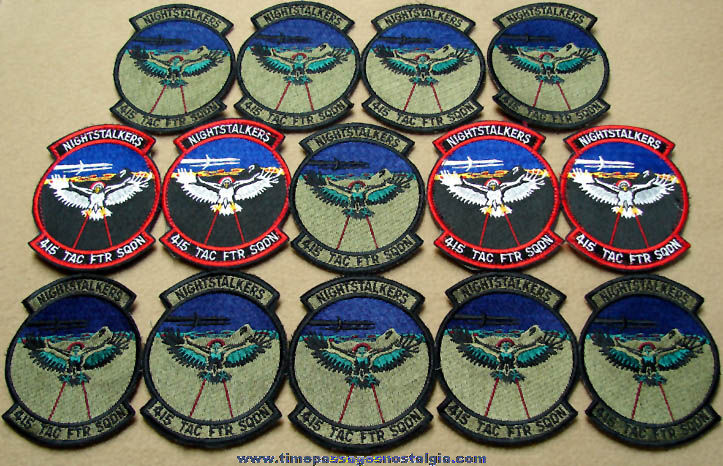
   | | Any group of items being offered as a lot must be sold as a lot. | | | | We have an extensive inventory that is not yet on our web site. If there is something you are looking for and did not find, please send us your wish list. | Quantity Discount Prices
(when available) | Quality Packing And
Postal Insurance | Whether you've collected Memorabilia for years or just want to feel like a kid again, please take a few moments to browse through what we
have available for sale. | | Fast Dependable Service | Don't forget to
bookmark this site. | | Combined Shipping And Handling | Nostalgic Memorabilia, Pop Culture Artifacts, Historic Items,
and "Shoe Box Toys" |
| | | | The picture shows a view of all (14) Unused U.S. Air Force Nightstalkers 415th Tactical Fighter Squadron Insignia Cloth Patches in this lot. These patches are not dated but they are believed to be before 1993 when the squaron was deactivated. The (4) colored patches have a velcro backing and the (10) darker ones do not. The insignia has an eagle and they are marked as follows: NIGHTSTALKERS
415 TAC FTR SQDN The patches each measure 3'' x 3-3/4''. They all appear to be in mint unused condition as pictured. Below here, for reference, is some additional information about the 415th Tacical Fighter Squadron: 415th Tactical Fighter Squadron
From Wikipedia, the free encyclopedia Active: 1942 - 1993
Country: United States
Branch: United States Air Force
Engagements: World War II, MTO Campaign (1943 - 1945), Southwest Asia Service (1990 - 1991) The 415th Tactical Fighter Squadron is an inactive United States Air Force unit. Its last assignment was with 49th Fighter Wing stationed at Holloman Air Force Base, New Mexico. It was inactivated on 30 July 1993 and redesignated the 9th Fighter Squadron. Operational history During World War II, the 415th Night Fighter Squadron first flew combat patrols in the Mediterranean Theater of Operations in 1943, then in 1944 and 1945 moved to France and later into Germany in the European Theater as a part of Twelfth Air Force. Returning to the United States after the war, it was assigned to Shaw Field, South Carolina. In June 1947, the 415th NFS was reassigned to Alaskan Air Command, being stationed at Adak in the Aleutian Islands. It flew training patrols until being inactivated on 1 September 1947, with its personnel and aircraft being assigned to the 449th Fighter Squadron (All Weather) upon inactivation. During the final phases of the War in Southeast Asia, the 415th was redesignated the 415th Special Operations Training Squadron, and operated AC-130A Spectre gunships out of Hurlburt Field, Florida, as a component of the 1st Special Operations Wing, June 1970 - June 1975.
During the final years of the Cold War, the squadron was reactivated on 5 October 1989 as part of the 37th Tactical Fighter Wing at Tonopah Test Range Airport, Nevada. The existence of the F-117A Nighthawk stealth fighter had just been made public, and its development unit, the 4450th Tactical Group was being inactivated, with the 37th TFW becoming the operational wing for the F-117. The 415th Tactical Fighter Squadron was activated and replaced the development 4450th Tactical Squadron (I-Unit). On 19 December 1989, just over two months after being reactivated, the F-117 was deployed into combat for the first time. This was in Operation Just Cause, the invasion of Panama intended to dislodge and arrest General Manuel Noriega. At the beginning of the invasion, six F-117As flew to Panama from Tonopah. Their mission was to drop 2000 pound bombs near the Panama Defense Forces (PDF) barracks at Rio Hato. The purpose of these bomb drops was to stun and disorient the PDF troops living there so that the barracks could be stormed and the troops captured with minimal resistance and casualties. The pilots were instructed to drop their bombs no closer than 50 meters from two separate PDF barracks buildings. On the night of 19 December, two lead F-117As each dropped a conventional 2000 pound bomb at the Rio Hato barracks.Less than a year later, in response to the Iraqi invasion of Kuwait on 2 August 1990, the 415th TFS was deployed to King Khalid International Airport, Saudi Arabia on 19 August 1990. On 17 January 1991, the Coalition began an air offensive to eject Iraqi troops from Kuwait. In the early morning hours, the F-117As of the 37th TFW initiated the air war against Iraq. Mission planners had assigned critical strategic Iraqi command and control installations to the F-117A, counting on the aircraft's ability to hit precisely at well defended targets without being seen. Other vital targets included key communications centers, research and development facilities for nuclear and chemical weapons, plus hardened aircraft shelters on Iraqi airfields. On the first night of the war, an F-117A dropped a 2000 pound laser guided GBU-27 Paveway III bomb right through the roof of the general communications building in downtown Baghdad. In another attack on the communications building next to the Tigris River, another GBU-27 Paveway III was dropped through an air shaft in the center of the roof atop the building and blew out all four walls. During the first three weeks of the air offensive, F-117As obliterated many hardened targets with unprecedented precision. The 37th TFW flew 1271 combat sorties and maintained an 85.5 percent mission capable rate. The 43 F-117As of the 37th TFW dropped more than 2000 tons of precision ordinance and attacked some 40 percent of the high value targets that were struck by the Coalition forces. Not one F-117A was hit, shot down, or lost to mechanical failure. There is no evidence that the F-117A was ever detected or tracked by Iraqi radar installations, either ground or airborne. The F-117's concealment, deception, and evasiveness proved that it could survive in the most hostile of environments, and its laser guided bombs struck with extreme accuracy. Most of the F-117As deployed to Saudi Arabia returned home to Tonopah in early April 1991. In July it was decided to move the F-117s from their development base at Tonopah, and they were reassigned to the 49th Fighter Wing at Holloman AFB, New Mexico. From 8 June - 7 July 1993 the 415th deployed to Gilze-Rijen Air Base in the Netherlands as part of Coronet Havoc. On 30 June the 415th Fighter Squadron was inactivated, with its F-117s being reassigned to the 49th's 9th Fighter Squadron. |
|
Click on image to zoom.
 |